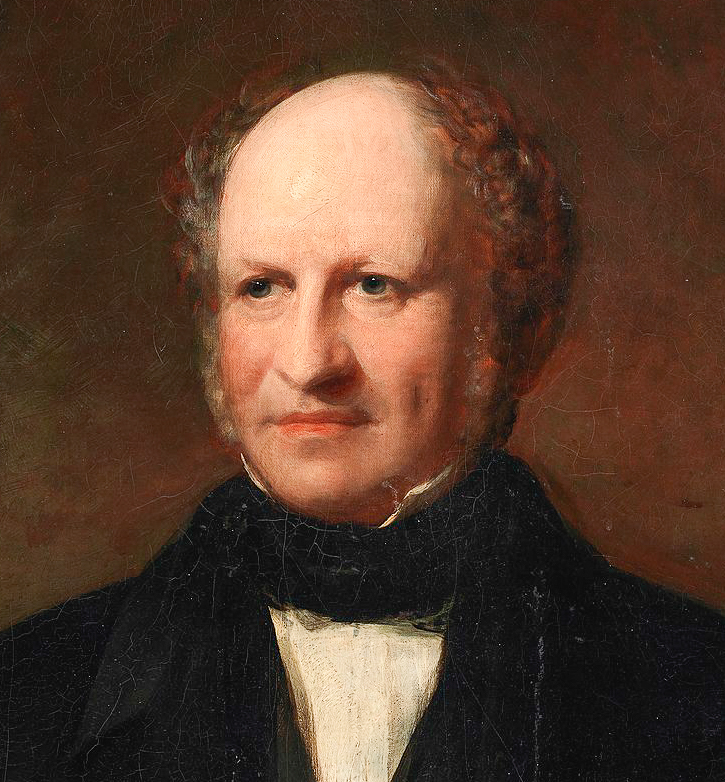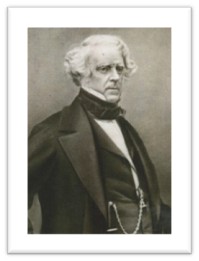
It is impossible to talk about the building of canals, roads and railways in Ireland in the 1800s without mentioning William Dargan (1799-1867). Born in Carlow in 1799, he was Ireland’s greatest 19th century civil engineer, involved in most of its major transport infrastructure projects. Dargan’s life has been expertly chronicled by Fergus Mulligan (2013).
Even if Dargan’s name is new to you, his achievements certainly won’t be. His companies built almost all of the Dublin & Belfast Junction Railway, including the Poyntzpass section, Craigmore Viaduct and the Egyptian Arch at Bessbrook. He was also responsible for ‘the cut’ in Banbridge, constructing Lough Island Reavey reservoir, dredging the Victoria Channel into Belfast harbour, creating Queen’s Island (home of Harland & Wolff) from the dredging spoil, constructing and operating the Ulster Canal, and building Portrush harbour…and a large number of other major projects, including the majority of Ireland’s other railways.
In his early years, Dargan worked under Thomas Telford in England on canal projects and on the London to Holyhead turnpike road. Indeed, he met and married his wife Jane Arkinstall in 1828 while working on the Shropshire Union Canal which was being built through her home village. Dargan built Ireland’s first railway, the Dublin & Kingstown, starting work on it in January 1833.
He was also a prolific and highly respected road contractor; at the 1840 Armagh summer assizes, county surveyor Henry Lindsey, while bemoaning the quality to which certain road contracts are being carried out, singled out Dargan for praise.
“…Mr Dargan, the contractor for making the new road from Armagh towards Caledon…has performed his contract strictly and has done more than was originally required of him – so much so that the road in question may be looked upon as a pattern for any public road in this or any country”.
This was typical of Dargan. He was known as an honest man who never resorted to shoddy materials to cut costs and who always paid his workers on time and in cash; he never used the ‘truck’ system which forced workers to buy tools and supplies from their employer at inflated prices. His honesty and his ability to deliver his projects on time and on budget made him very successful.
At the height of the famine, Dargan directly employed over 20,000 men, and the wages he paid supported at least 100,000 Irish men, women and children through the very worst of times. It is no exaggeration to say that William Dargan probably personally saved tens of thousands of lives during the Great Hunger, by providing his men with steady employment and a fair wage, promptly paid.
In the late 1840’s a contractor called Burge under-bid Dargan for a contract for repair work on the Newry Canal but then defaulted. The Navigation Company had to sack Burge and bring the work in-house. A director stated publicly:
“…if a contract had been made with Mr Dargan, there is little doubt but the works would have been completed by him in less than half the time now elapsed, as his energy and respectability are well known. In fact, he has executed more works on the harbour of Belfast within these last two years than all those on which nearly seven years have been spent in the port of Newry.”
For all his immense achievements, the great engineer died in much reduced circumstances after losing a substantial part of his fortune in a series of unwise investments.
His statue stands outside the National Gallery of Ireland, which he also built.
Sir John Macneill
Sir John Macneill

For all of Dargan’s great achievements, Sir John Macneill was equally important in the story of the D&BJR, and of many other Irish railways.
Macneill was appointed as the D&BJR’s ‘engineer’, the man responsible for every aspect of its planning and design. He had the possible routes surveyed and chose the final route, provided the specifications against which Dargan and others bid for contracts, designed the stations, bridges and viaducts – notably the Boyne Bridge, the Craigmore Viaduct and the Egyptian Arch – and supervised construction to ensure that contractors fulfilled their obligations. He reported to the Board of Directors (with whom he had an often-fractious relationship).